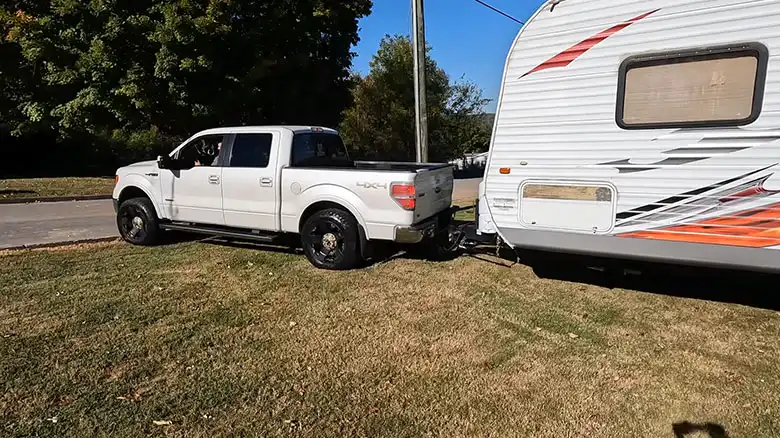When you hitch your trailer to your vehicle, you might notice your ride dipping at the back. This downward tilt is called “sag.” While some sag is inevitable, it’s essential to understand how much is acceptable and when it becomes a cause for concern.
The acceptable amount of sag depends on several variables, including the make and model of your vehicle, the trailer, and the suspension system. In general, a modest amount of sag is normal, but it should not exceed 1 to 2 inches.
This guide contains all relevant information related to sag that can ensure you a safe and smooth towing experience. All you need to do is read the entire guide without skipping any part.

Understanding Acceptable Towing Sag Levels
Towing sag occurs when the rear end of your tow vehicle lowers due to the weight of the trailer or load. It’s a natural response to the additional weight, but excessive sag can lead to problems with safety, handling, and vehicle wear and tear.
When towing a trailer, it is normal for the rear of the tow vehicle to sag somewhat. This is because the trailer is adding weight to the rear end of the vehicle. However, too much sag can be dangerous, as it can affect the handling and braking performance of the tow vehicle.
There is no one-size-fits-all answer to how much sag is too much, as the amount of sag that is safe will vary depending on the tow vehicle, the trailer, and the load being towed. However, a general rule of thumb is that the rear of the tow vehicle should not sag more than 2 inches below its unloaded height.
Key Factors That Affect Towing Sag
1. Tongue Weight
Tongue weight is the force exerted by the trailer on the hitch. It plays a significant role in determining sag. If the tongue weight is too high, your vehicle’s rear end will sag excessively.
2. Trailer Weight
The total weight of the trailer, including its contents, has a direct impact on sag. Heavier trailers will cause more sag than lighter ones.
3. Suspension System
Your vehicle’s suspension system influences how it handles additional weight. Well-maintained and robust suspensions can mitigate sag, while worn-out systems may exacerbate it.
4. Hitch Type
The type of hitch you use, such as a weight-distribution hitch or a sway control system, affects how weight is distributed and, consequently, the extent of sag.
5. Vehicle Make and Model
Different vehicles have varying load-bearing capacities. Smaller vehicles will generally experience more sag when towing heavy loads.
Why Managing Towing Sag Is Important for Safety
To measure sag, park the tow vehicle on a level surface and measure the distance from the ground to the bottom of the rear axle. Then, load the tow vehicle with the trailer and cargo, and measure the distance from the ground to the bottom of the rear axle again. The difference between these two measurements is the amount of sag.
Effective Tips to Minimize Towing Sag
1. Reduced Traction and Stability
Sag shifts weight from the front wheels of the towing vehicle to the rear wheels, reducing traction and stability. This can lead to difficulties in steering and braking.
2. Altered Headlight Aim
Sag can point your headlights higher than intended, potentially blinding oncoming drivers and reducing your ability to see the road clearly.
3. Uneven Tire Wear
Sag increases the load on your rear tires, causing uneven wear and reducing their lifespan.
4. Strain on Vehicle Components
Prolonged sag can lead to wear and tear on your vehicle’s suspension, braking, and transmission systems, potentially resulting in costly repairs.
How To Reduce Sag?
If the rear of the tow vehicle is sagging more than 2 inches, there are a few things you can do to reduce sag –
Use a weight distribution hitch. A weight distribution hitch helps to distribute the weight of the trailer more evenly between the tow vehicle and the trailer. This can help to reduce sag and improve the handling and braking performance of the tow vehicle.
Increase the tire pressure in the rear tires of the tow vehicle. This will help to support the additional weight of the trailer.
Reduce the load in the trailer. If possible, try to reduce the weight of the trailer by removing unnecessary items.
Consult with a qualified RV technician. If you are unsure about how much sag is safe for your tow vehicle or if you are having trouble reducing sag, it is always best to consult with a qualified RV technician.
End Note
Understanding and managing towing sag is crucial for a safe and pleasant towing experience. It’s a delicate balance between carrying the load you need and maintaining the safety and performance of your vehicle. By following the guidelines outlined here, you can keep sag within acceptable limits and enjoy worry-free towing adventures. Remember, safety always comes first on the road.


